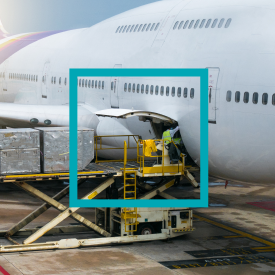COVID-19 sent the aviation industry into a record-breaking crisis. Many countries drastically reduced or completely shut down their air traffic operations, and the number of air travelers decreased by nearly 70%.
Many consider the speed and significance of the pandemic to have more harmful effects on the industry than the financial crisis, September 11, the Icelandic ash cloud, and everything else seen in the world of aviation since World War II.
Across the globe, airports adapted their operations to fit the rapid reduction of air traffic and paying passengers. They introduced reduced payments, increased flight flexibility, salary reductions, rotations, and more in an effort to cruise through the harsh effects of the pandemic.
Why Airports Put BI Operations on Standby
Airports were quickly advancing their business intelligence (BI) maturity before COVID-19 came onto the scene.
A few years ago, the typical airport analytics solution combined outdated legacy systems, spreadsheets, and in-house technology cobbled together to build reports and analyze data. But at the beginning of 2020, airports quickly discovered that investing in modern, scalable BI and analytics technology could give them visibility into every aspect of their operations in a single, easy-to-use interface.
Even smaller airports were planning for ongoing IT investments and more advanced technology to help them reduce wait times and improve security. The market’s advanced queue management solutions offered fast-moving alternatives to their legacy counterparts.
Airports’ priorities shifted dramatically and quickly during the pandemic. Once-urgent expansion efforts were replaced with fast-paced initiatives to keep passengers on board and maintain revenue. For many, investments in operational and BI were added to the list of stalled or even canceled projects. Even active BI contracts were reduced or closed to accommodate mission-critical activities.

Now, we’re seeing a revival of the ideas that were put on hold two years ago. We’re also seeing a considerable difference in how quickly airports recover from setbacks and accelerate their BI strategies.
Now, It’s Time to Act—and It’s Never Too Late To Get Started
Today’s airports are in search of robust data systems that pull from every data source and present information in easy-to-understand dashboards, so users can make decisions instantly and plan for the future better with real-time access to passenger information.
To extract the full value of their analytics data, airports must collect, analyze, and share it in real time. Even a five-minute delay won’t do much good if the goal is to prevent security delays and queue pile-ups.
An airport analytics solution can connect to devices that follow each passenger precisely throughout the entire airport in real-time. These devices use heat maps and passenger flows to see where airport visitors spend their time–in queues, duty-free shops, or restaurants–and for how long.
"The visibility we gain with TARGIT is very important for our entire business."
Bala Baskaran
Data Engineering & Platforms Manager at Dublin Airport DUB
Some airports use weight sensors in their terminal trains to estimate how many passengers are on their way to particular terminals at any given moment. When paired with an integrated BI solution, these tools managers identify issues before they happen, not when they happen. Instead of focusing on queue bottlenecks as they form, managers can use data-driven insights to streamline operations and send in more agents before they happen.
Airports Need To Streamline Resources and Prioritize Intelligence
Backend functionality and connectivity are essential, but an airport’s BI and analytics solution must also work for its users – not the other way around.
Forecasting and reporting software shouldn’t leave analytics chained to a desk all day watching the data change or tediously updating analyzers. Staff should be able to easily share data with the people who need it when they need it. They need reliable, intuitive tools to send out routine insights and time-sensitive alerts when data falls outside a specific parameter or a critical event occurs.
The right data analytics tools allow users to work where they are most needed—such as on the floor or away from the computer making important decisions—which frees up critical resources and stretches those that exist. Employees are empowered to do more with the confidence that the airport’s BI solution will alert them when something needs their attention.
In Ireland, Dublin Airport (daa) counts on TARGIT for accurate passenger forecasting in easy-to-use analytics dashboards. With TARGIT, Dublin Airport reported 97% accuracy on passenger forecasts, despite having a similar percent increase in passengers year-over-year.
Before COVID, numerous airports were operating well overcapacity. Those without a reliable IT infrastructure or intelligence solution struggled to effectively manage passengers and airport employees. On the other hand, those that relied on a comprehensive BI and forecasting solution were operating efficiently at more than double their passenger capacity.
At a time when airport resources are stretched to their limits, airport employees need to focus on passengers rather than complicated backend analysis tasks. That’s why an investment in BI can actually be even more impactful than investments in building and terminal expansion.
2022, Away We Go
It’s unlikely that the growth of air travel will slow any time in the coming years. Once they establish a “new” normal, airports need to use their current resources to prepare for the future. They’ll lean on BI tools and other technology to implement:
- Streamlined security systems
- Improved queue management tools
- More accurate passenger forecasting
While these efforts focus on seemingly distinct elements of airport operations, they’re all linked by a common foundation: highly accurate, accessible data.
The right BI solution will seamlessly scale up or down with need, making it possible for airport employees to do so much more with less. Forecasts are accurate, managers are better prepared, and airports can deploy resources where they are needed most.

Download TARGIT’s Airport Analytics Guide to Discover Seven Benefits of An Effective BI Strategy
Download our free guide Improve Airport Operations With Analytics to take a deep dive into the role of BI and analytics in airport operations. You’ll find out how you can achieve the seven most important benefits of an airport analytics strategy.
Learn the most important airport key performance indicators (KPIs) and see how easy it should be to get all the information you need at a glance in dashboards and user-friendly data visualizations.
.png)



.png)
